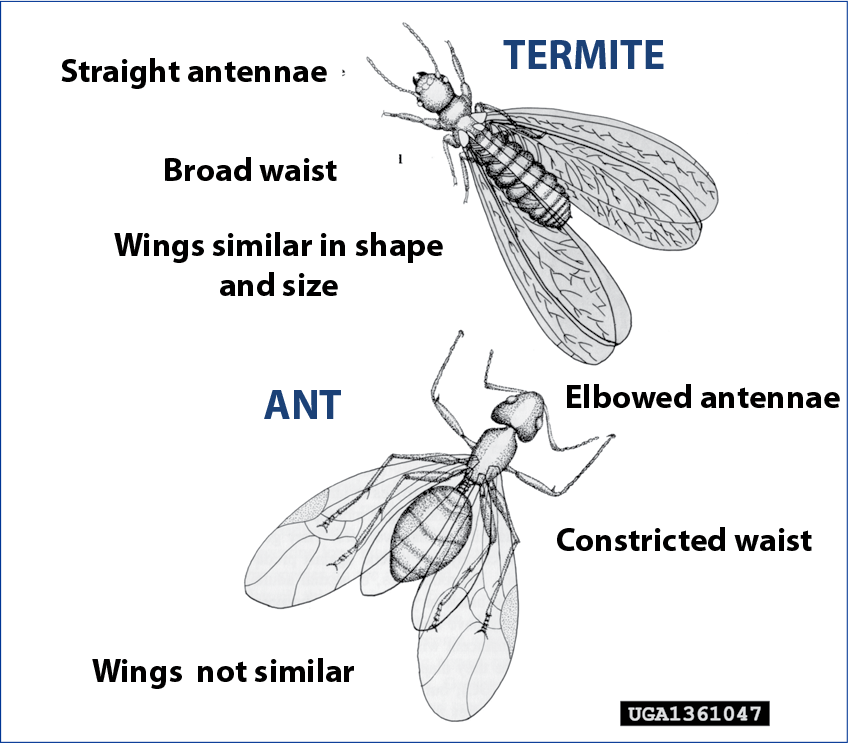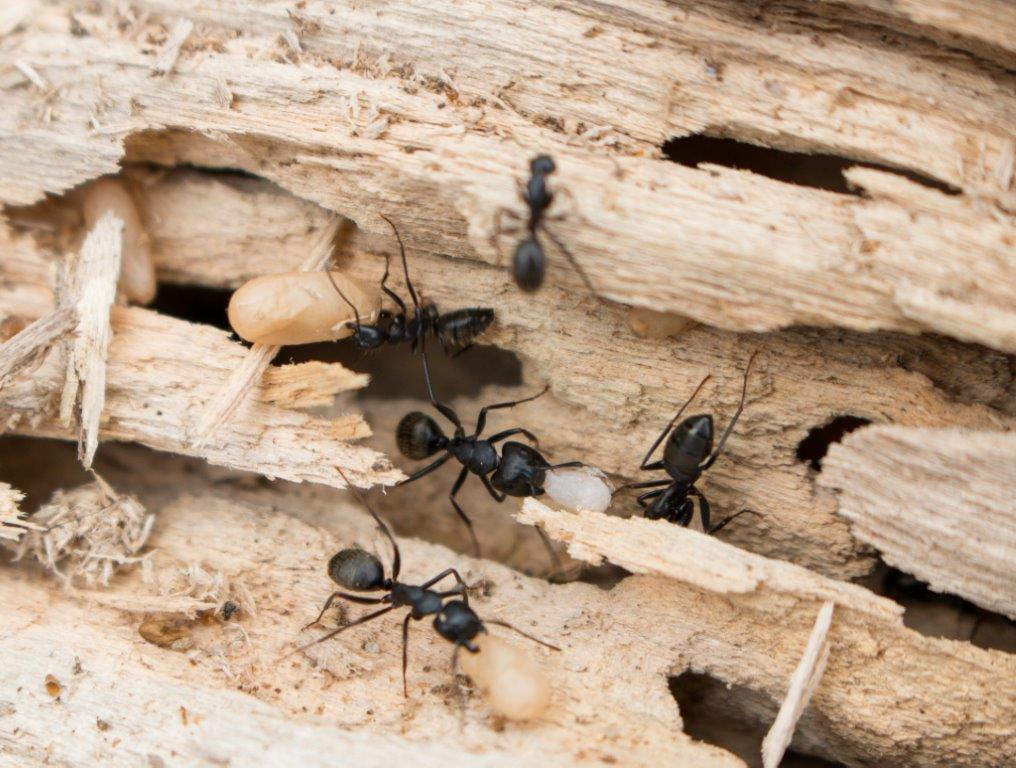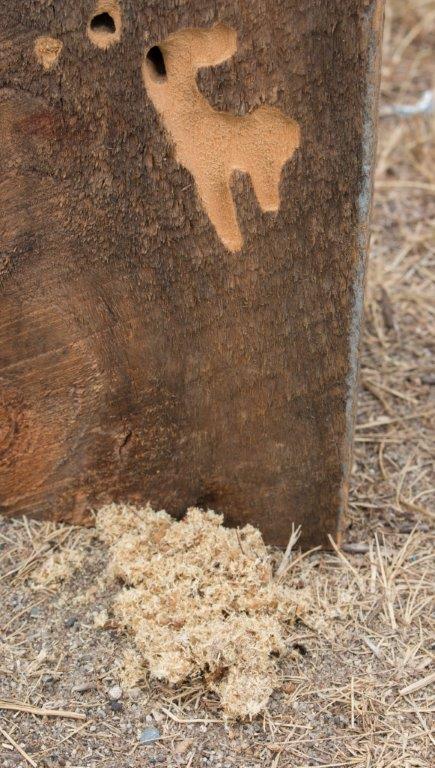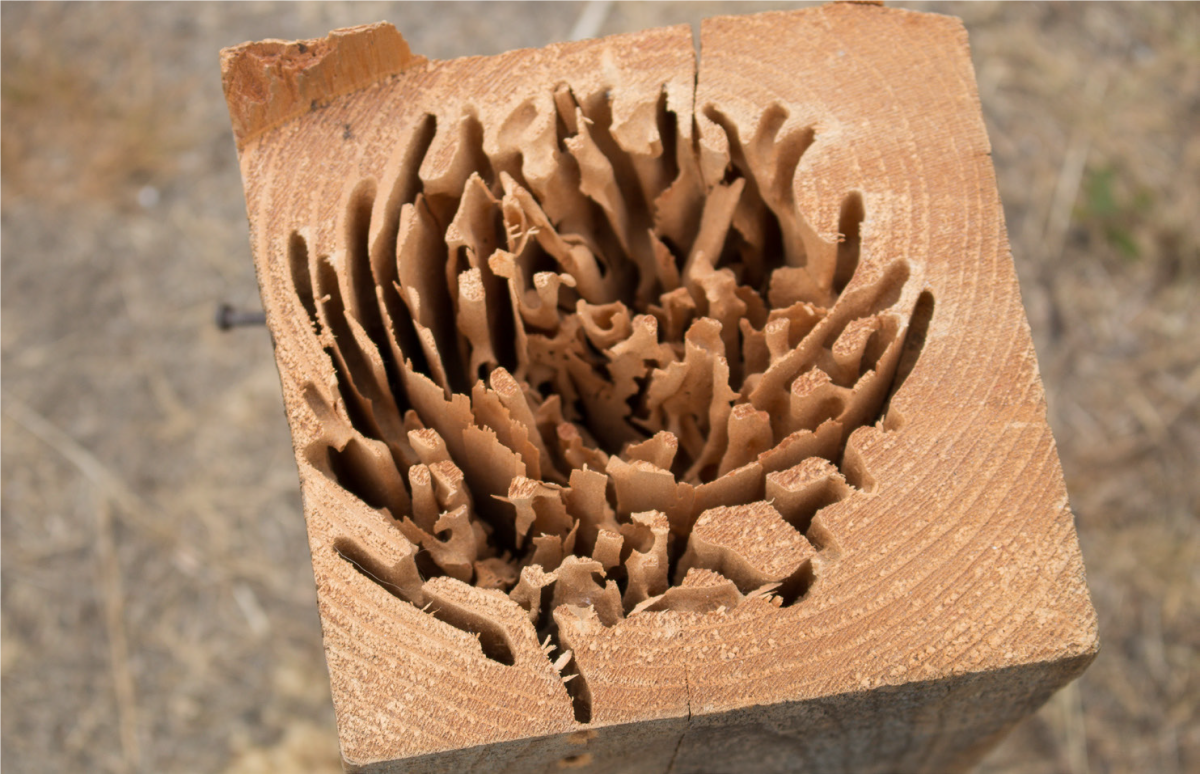Carpenter ants (Camponotus spp.), along with termites, are the most troublesome structural pest in New Hampshire. Four species live in the state, three entirely black, the fourth black with a red-brown midsection. Adults workers vary in length from ¼ to ½”, while adult queens are ¾” long. Only the reproductive forms (kings and queens) have wings; they shed their wings before selecting a nesting site.
Winged carpenter ants are frequently confused with winged termites. Winged termites are found in early spring and can be easily distinguished from ants using the diagram on the right side of this page. If you see relatively large, black ants of different sizes indoors, and they are not fighting, probably they are carpenter ants. With the use of a microscope, an entomologist can confirm the identification of a worker to species. Winged adults are harder to identify.

USDA Forest Service, Bugwood.org.

Harvard University, Bugwood.org (top) and Alan T. Eaton (bottom).
Life Cycle and Habits
A single winged female carpenter ant begins a colony by shedding her wings and selecting a desirable nesting site, generally moist wood that has weathered and begun to decay. In buildings, this may be in porch columns, steps, corners, under eaves, between walls, in door and window frames, beams, and joists. Outdoor nests are frequently found in woodpiles, stumps, fences, telephone posts, and rotten trees. Therefore, foraging ants found within a building may come from a nest established either within the building or from outdoors.
Carpenter ant workers do not eat wood as termites do, but excavate galleries to rear their young. Unlike termite galleries that are packed with a mud-like deposit, carpenter ant galleries are clean with smooth walls. Carpenter ants feed on other insects, aphid honeydew, plant juices, sweets, and scraps of food.
During the winter the nests are inactive, but individuals occasionally come out on warm days. Winged males and females emerge in the spring and summer. A new colony will increase and survive for several years. They strongly prefer damp wood for excavating.


China Wong, UNH.
Management
IPM Strategies:
- Cultural Practices - Preventive measures include eliminating stumps, storing firewood away from the house and off the ground, reducing humidity, and preventing structural wood from getting wet. This may require repairing plumbing leaks, improving the ventilation in crawl spaces, and making roof or structural repairs. Improving ventilation will be especially helpful in basements, attics, and crawl spaces. Keeping trees and bushes from touching the house will reduce the chances of foraging ants coming indoors.
- Monitoring - To control carpenter ants, it is essential to locate and apply the chemical control directly to the nest. The presence of “sawdust” does not prove you have found the nest; it only suggests carpenter ant activity. Look in places most likely to harbor moist wood, such as porch floors and columns, eaves, sills, roof joints, and in the wood below leaking roof gutters. You can recognize the nest as the place where you find ant pupae and larvae. In some situations, it may be possible to eliminate the nest by removing the wood it is in. When you disturb a nest, the ants quickly carry the white, oval pupae (often mistaken for eggs) and the white, worm-like larvae to safety.
By watching the activities of worker ants you can often discover their avenues of entrance into walls and moldings. Sometimes, by feeling with your hand, you can detect an increase in temperature in the wood where the nest is located. Outdoors, inspect piles of wood, old stumps and trees with rotted wood. Branches hanging over and touching the roof of the house may be inviting outdoor ants to enter the building.
- Chemical Control -You can get some reduction in ant numbers by applying pesticides to baseboards, moldings, sills and behind appliances. Due to recent regulatory changes, there are fewer products available for use by someone without a pesticide applicator’s license. Pressurized aerosol sprays are not designed to give effective, longlasting ant control, so we do not recommend them for carpenter ants.
Bait cups for ants are widely available. Except in spring, it may be hard to get carpenter ants to consume baits, however. Gel and liquid bait forms are probably more effective than granules for carpenter ants; a sugary bait is best. Bait cups are not an effective approach for serious carpenter ant infestations, however. If you see large numbers of ants indoors and suspect a severe infestation, we recommend consulting a licensed pest control firm. Professional exterminators have access to stronger, longer-lasting pesticides not available to the general public.
Perimeter sprays around the outside of foundations, windows and doors may kill foraging ants and help keep outdoor ants from migrating indoors. New products available to the general public contain very low concentrations of different active ingredients and may not be as effective as those available to licensed pesticide applicators.


of the beam (top) and cross-section of the same beam showing the amount of damage
within the beam (bottom). Credits: China Wong, UNH.
Stop! Read the label on every pesticide container each time before using the material. Pesticides must be applied only as directed on the label to be in compliance with the law. All pesticides listed in this publication are contingent upon continued registration. Contact the Division of Pesticide Control at (603) 271-3550 to check registration status. Dispose of empty containers safely, according to New Hampshire regulations.
Download the resource for the complete factsheet.

